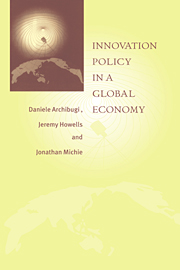Book contents
- Frontmatter
- Contents
- List of figures
- List of tables
- List of contributors
- Foreword
- Preface and acknowledgements
- 1 Innovation systems and policy in a global economy
- Part I National systems of innovation
- Part II Regional, national and global forces
- Part III Globalisation and economic performance
- 9 The political economy of globalisation
- 10 The geographical sourcing of technology-based assets by multinational enterprises
- 11 Innovation as the principal source of growth in the global economy
- 12 The policy implications of the globalisation of innovation
- Index
10 - The geographical sourcing of technology-based assets by multinational enterprises
Published online by Cambridge University Press: 05 November 2009
- Frontmatter
- Contents
- List of figures
- List of tables
- List of contributors
- Foreword
- Preface and acknowledgements
- 1 Innovation systems and policy in a global economy
- Part I National systems of innovation
- Part II Regional, national and global forces
- Part III Globalisation and economic performance
- 9 The political economy of globalisation
- 10 The geographical sourcing of technology-based assets by multinational enterprises
- 11 Innovation as the principal source of growth in the global economy
- 12 The policy implications of the globalisation of innovation
- Index
Summary
The changing nature of foreign direct investment
Until about a decade ago, the received theory of foreign direct investment (FDI) asserted that firms established foreign value-added activities in order to exploit their home-based competitive (or ownership-specific (O)) advantages, and to benefit from the internalisation of cross-border intermediate product markets. To be sure, there was some natural resource seeking foreign direct investment (FDI), designed to gain access to agricultural products, raw materials and minerals not available, or not available on such advantageous terms, in the investing country. Multinational enterprises (MNEs) also invested in developing countries to take advantage of low cost and/or more productive unskilled or semi-skilled labour. However, in each of these cases, as with market and efficiency seeking FDI, the main objective of the investing firms was to seek out the location specific assets of foreign countries, which could be used in conjunction with their own mobile O specific assets, which, in turn, were assumed to reflect the availability and quality of created assets in their home countries.
World economic events of the last decade – particularly the globalisation and liberalisation of markets, a new generation of technological and organisational advances and the emergence of third world countries as significant sources of FDI – have changed the economic environment for MNE activity. While, as with exports and licensing arrangements, international production continues to be a means of capturing economic rent on the O advantages of the investing companies, increasingly firms are investing abroad to protect or augment their core competencies.
- Type
- Chapter
- Information
- Innovation Policy in a Global Economy , pp. 184 - 224Publisher: Cambridge University PressPrint publication year: 1999
- 13
- Cited by



